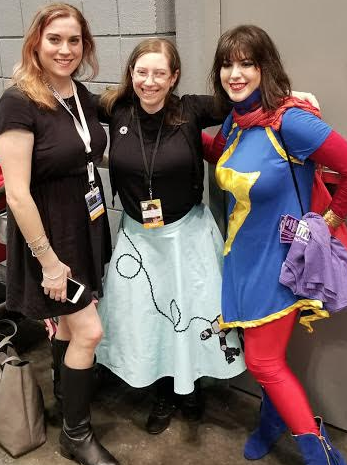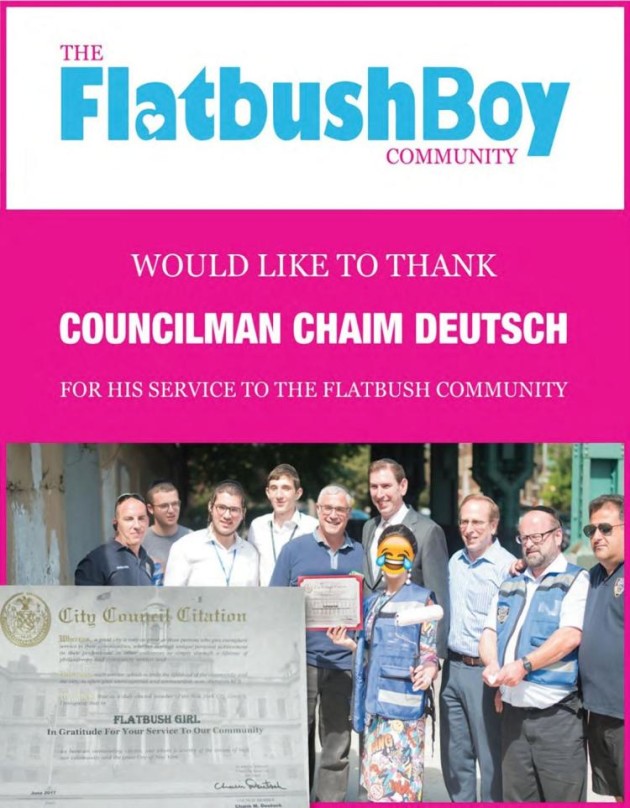Author Archives: Rebecca Mordechai
November 20, 2017 by Rebecca Mordechai
Jewish, Feminist, and Into Star Wars? There’s a Podcast for That.

From left to right: Tamar Herman, Michal Schick, and SM Rosenberg at New York Comic Con 2017. Photo credit: Avi Weinberg
Let’s do a bit of math: What do you get when you add together three Jewish girls and an array of opinions on Princess Leia, Stranger Things, and sci-fi? One revolutionary podcast that documents the intersection between Jewishness and fandom.
Nice Jewish Fangirls is a collaboration among Michal Schick, 30, Tamar Herman, 26, and Sarah Meira (SM) Rosenberg, 28, Modern Orthodox millennials who are as passionate about the feminism of Hermione Granger as they are inquisitive about how Judaism plays a part in the Harry Potter franchise. (If only J.K. Rowling would write a spin-off called Anthony Goldstein and the Magical Menorah.)
“There’s not many public forums for women in fandom, especially for Orthodox women,” Michal informed Lilith during a meeting. Before the podcast, Michal began the Facebook group Orthodox Ladies United by Fandom (OLUF). Michal’s group now has close to 2,000 women (of various Jewish affiliations) who eagerly test each other’s knowledge of Doctor Who and discuss why they’ll be watching Star Wars and Captain America over Chanukah.
Through OLUF, Michal formed a bond with Tamar and SM, two other self-professed geeks. Together, they partnered with Jewish Coffee House and created their podcast. “People don’t identify their Jewish identity or female identity with fandom, but we wanted to encourage people to do that,” said Michal.” Their platform validates Jewish fangirls’ obsessions and also works to address two levels of disenfranchisement.
- 2 Comments
October 31, 2017 by Rebecca Mordechai
No Halloween Ghoul Can Compare to the Fear That This Jewish Ritual Inspires
 Halloween superstitions (cue black felines stretching taut bodies on still roads) reign in the dusks of October. But the ghost of my former Orthodox self is hardly affected by these scares. Jack-o-Lanterns and Dracula costumes remind me only of America’s perpetual urge to capitalize on basic human instincts (in this case, of course, fear). They are child’s play compared to the one superstition that haunted me most: the Evil Eye.
Halloween superstitions (cue black felines stretching taut bodies on still roads) reign in the dusks of October. But the ghost of my former Orthodox self is hardly affected by these scares. Jack-o-Lanterns and Dracula costumes remind me only of America’s perpetual urge to capitalize on basic human instincts (in this case, of course, fear). They are child’s play compared to the one superstition that haunted me most: the Evil Eye.
Yes. The Evil Eye, or as it is known in Hebrew, the ayin hara.
Ayin hara is the gaze born of envy. This gaze can do more than merely make its victim feel uncomfortable. It can be the origin of the victim’s sudden bout of sickness, misery, and even death. The Torah mentions ayin hara and states that the only group protected from its possible calamity are the descendents of the biblical hero, Joseph.
Over afternoon Shabbos teas and communal challah bakes, women have been peppering their conversations with “bli ayin hara” (“without an ayin hara”) for generations: “Mrs. Schwartz has seven children, bli ayin hara” or, in Yiddish, “My father is 80 years old, kayn ayn hora.” These three words continue to be a verbal amulet against anyone who may be jealous of another’s progeny or long life.
***
My family emigrated from Baku, Azerbaijan to the States in 1989. While Azerbaijan’s main religion is Islam, it’s also important to note to that many Romani groups live in the country. Not surprisingly, Islamic and Romani rituals against the Evil Eye have all combined to heighten my culture’s terror of the ayin hara. Since I was a child, I could barely keep count of how many times my swarm of relatives let the words “ayin hara” tumble out of their lips with a dread that rivaled words like “cancer.”
My mother coaxes:
“Be careful, Rebecca. That dress shows off your figure. Don’t wear it, you may get an ayin hara.”
“Don’t participate too much in class, Rebecca. Your friends may be jealous of your smarts and give you an ayin hara.”
Or she laments in hushed tones:
“My handsome and successful son is not married yet because he got an ayin hara when he was younger.”
“Your father’s brother passed away when he was a child because someone gave him an ayin hara.”
And then, the panic:
“We may get sick because of ayin hara! We may lose our money because of ayin hara! We may die because of ayin hara!”
Madonna made the red string (believed to ward off the Evil Eye) Kabbalah-chic, leading self-proclaimed bohemians and yoga instructors to tout them on wrists and ankles. But, according to Azerbaijan’s Jewish lore, salt sprinkled over one’s head and then burned is the true antidote against ayin haras. If I ever broke out in a raging fever, received an unexpected slew of bad grades, or waddled in a stage of adolescent loneliness, my mother would usher me to her side with salt in her palm.
“Those who gave you the Evil Eye should be destroyed like this salt will be destroyed,” she proclaimed.
There was palpable fierceness to her words, to her motions, and to her eyes.
“Mom’s like a witch,” my brother looked on and laughed.
I was not laughing. Instead, I watched the salt burn beneath the eager blaze.
***
As a thirteen year old, making sense of cruel social cliques, my sudden rebellious body, and increasingly difficult math problems to solve, I felt close to powerless. I needed something raw and forceful to blame for the misfortunes that teenagehood inflicts. And so, immersed in a culture that enclosed me in its walls of superstition, I quickly became obsessed with the Evil Eye.
First, there was the paranoia. Paranoia that my friends, teachers, and even my own family, were blasting ayin haras my way. As I turned my back, I imagined their eyes, like caricatures of every demon-possessed child in horror movies, shot Arctic rays of envy through my spine: I will fail my next test because of them. I will have no friends because of them. I will grow to be ugly because of them.
Second, were the chants. With a mouth moving fast in worry, I murmured the following under my breath every time I felt like I was the recipient of the Evil Eye (which was, on average, five times a day): “May the Evil Eye that (blank) is giving me be completely destroyed.” I chanted this personalized prayer ten times in a row. It must be said ten times, otherwise I would amount to tepid nothingness. Five Evil Eyes + ten chants per Evil Eye equals to 50 chants per day.
Third, was the insomnia. Insomnia was the Rosemary’s baby that my paranoia and excessive chanting conceived. It taunted me every night in middle school. My hands were unsteady as I lifted a glass of caffeinated tea in the morning, and I arrived to class with knotty hair and cartoonishly large eye bags.
Fear of the Evil Eye, and its consequences, chased me from middle school to high school. This fear was only murdered when l was finally driven away from the rituals of a cloistered lifestyle in college. By then, I had become not only emotionally exhausted from years of superstitious beliefs, but also from religion itself. Both superstition and my ultra-Orthodox upbringing have been charged, mercilessly, with fear and paranoia. The synapses that were responsible for firing thoughts like “If I wear my new dress, I’ll get an Evil Eye” also fired thoughts like “If I don’t dress modestly, God will punish me.” Rumination bred obsession which bred anxiety which bred meaninglessness. And meaningless is the antithesis of what religion is proud to brag to its disciples.
On this Halloween, as its nostalgic reruns of Hocus Pocus and a new season of Stranger Things entertain millions, I know that I will dwell on my past hauntings.
The views and opinions expressed in this article are the author’s own and do not necessarily reflect those of Lilith Magazine.
- No Comments
September 7, 2017 by Rebecca Mordechai
Due on Tuesday: Lesson Plans and a Xanax. The Challenges Facing One Female Teacher.

Photo credit: Kevin Dooley
“You need to clap harder if you want the class to shut up and listen!” pointed out Michael, one of my most challenging students.
“I’m trying my best to clap loudly, but my hands are not that strong,” I replied. I demonstrated another clapping in front of the class, but the sound that emanated from my delicate palms was, frankly, pathetic. Michael giggled.
It was at that moment that I became frustratingly aware of my dainty femininity, and how it was no match for the adolescent cacophony of slang, whooping, taunts, and laughter.
“You need to yell!” piped up Eva, another student who can summon the gall to critique my classroom management techniques publicly. “Intimidate us!” With the steady rise of 35 teenage voices threatening to overpower my authority, I finally did yell.
“Enough!” I shrilled, while slamming a textbook on my desk.
My voice, filled with bone-shaking ire, silenced even the loudest student. Michael and Eva were correct: I needed to establish a dominant physical and audible presence if I wanted this class to finally shut up and listen.
After I dismissed the class, I sighed and sank my body on a chair. I felt firm stress knots criss-crossing across the expanse of my shoulder blades, an MTA-like subway grid of burnout and despair.
- 2 Comments
August 23, 2017 by Rebecca Mordechai
Subversion, Sex, and Savoy Cabbage: Reclaiming Azerbaijan’s Jewish Cooking

Photo credit: Lou Robinson
“Can I cook with you?”
“Repeat what you said.” Blatant surprise lingered in my mother’s voice.
That was to be expected. I can master only the contents of a kid’s menu: mac and cheese, home fries, perhaps, if I’m feeling fancy, breaded chicken cutlets. What my mother makes, however, is the Russian novel of cuisine—layered, complicated, and undeniably time-consuming.
But I was having guests over for Shabbat dinner and I wanted to be as Martha Stewart as possible. My guests were Ashkenazic millennials who, after decades of munching on potato kugel, craved to challenge their palates with Eastern saffron and sumac.
“Can you cook a dish with your mom?” Erica asked, as she was lounging on my couch one day.
“Yes. You’re from Azerbaijan. Cook lamb!” Josh piped in from the kitchen.
But my friends didn’t quite comprehend how Azeri Jewish cuisine signifies a weighty inner conflict, and why I often resist cooking it.
***
- No Comments
August 3, 2017 by Rebecca Mordechai
An Emoji Worth a Thousand Words: One Orthodox Woman Uses Humor to Become Visible

Flatbush Jewish Journal
When Hillary Clinton’s face was covered by the image of a hand in a 2016 copy of an Orthodox newspaper, I choked on my coffee. In the age of ‘woke’ and social activism, concealing the former presidential candidate, in all her strength and pant-suited glory, seemed downright bizarre. I immediately took to Facebook to lambast the ridiculousness of this photo. “Gloria Steinem would be so proud I tell ya,” I posted, earning just one like and one comment.
Unlike me, Adina Miles, an Orthodox 29-year-old mother of two, has the pluck and the platform to get hundreds of people talking about how absurd it is to conceal women’s faces in conservative Jewish publications.
It all started when Miles created @FlatbushGirl, an Instagram account documenting the everyday life of an Orthodox woman—comedic mishaps when baking challah, and shopping for jewelry with an opinionated mother-in-law. After posting several clever and relatable videos for the Orthodox community, Miles’s account swiftly accumulated thousands of followers. Miles then decided to leverage her newfound public persona to create a cleaner environment in Flatbush, the epicenter of Brooklyn’s Orthodox community. She partnered with Councilman Chaim Deutsch of Brooklyn to paint over local graffiti, and posed near him (and other community activists) in a photo for the Flatbush Jewish Journal (FJJ).
- 1 Comment
 Please wait...
Please wait...